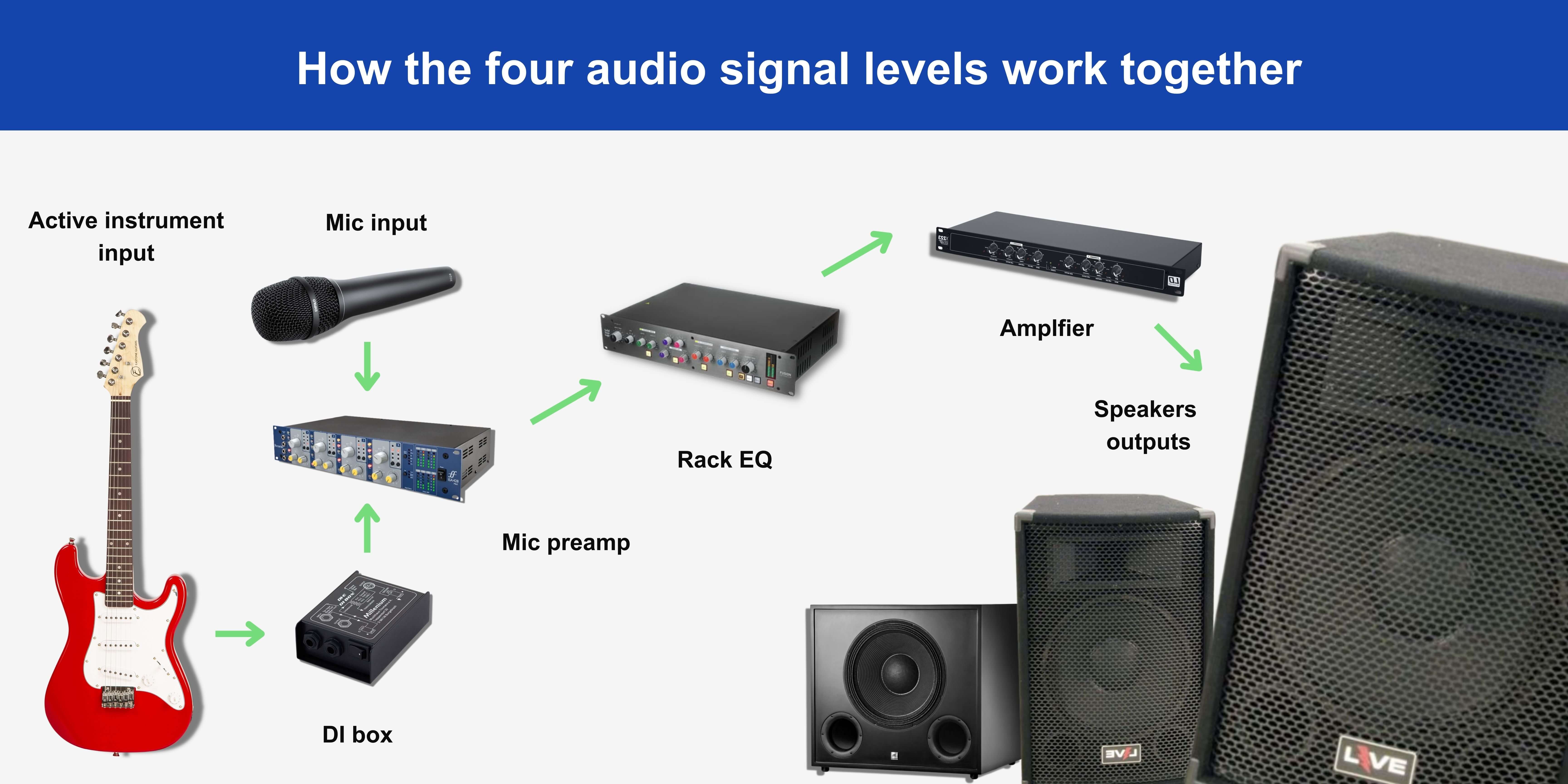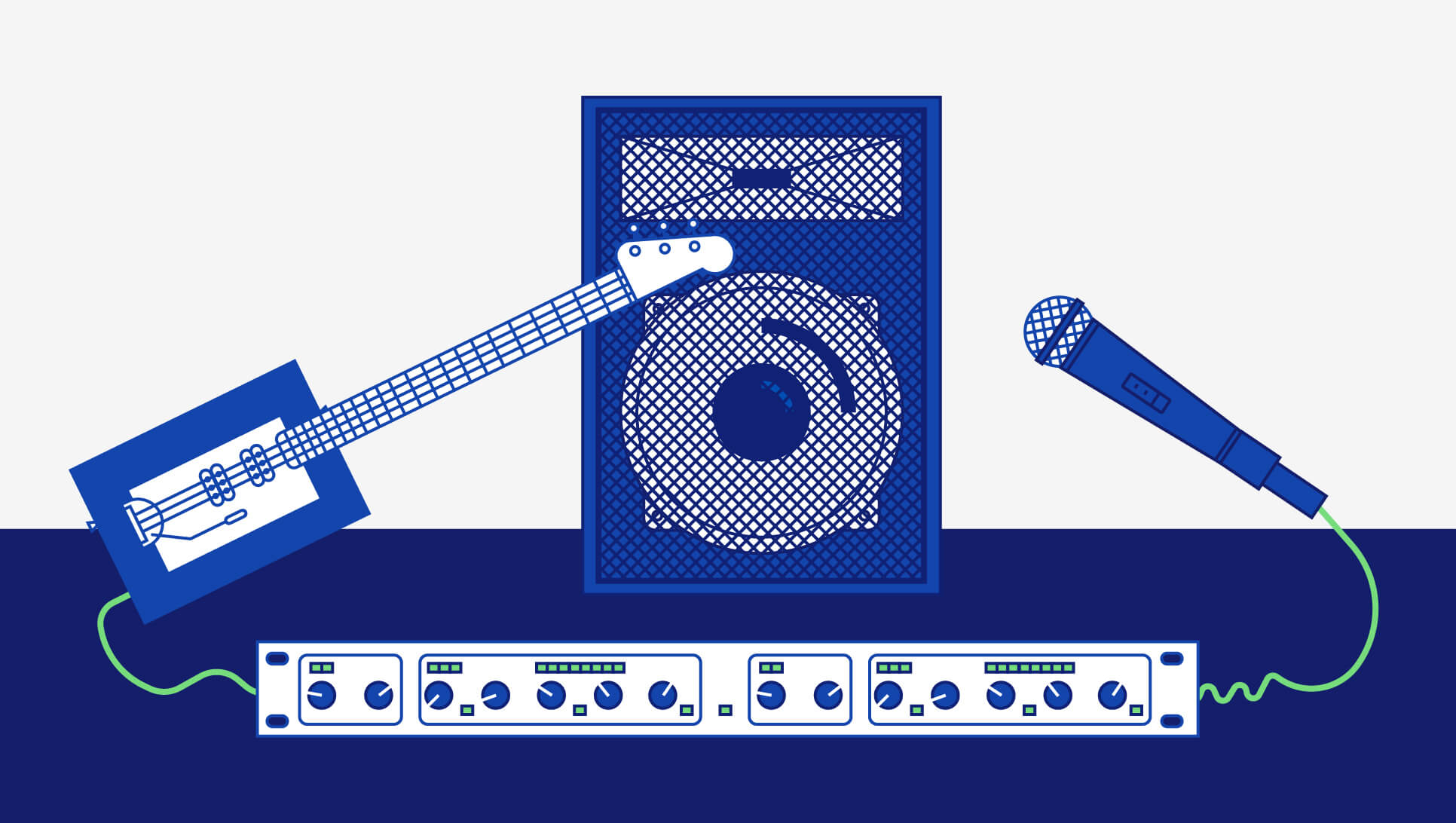How do audio signals work? How voltage and sound intertwine
Differing pieces of audio gear output and process different audio signals. In fact, it’s easy to identify and match up three of the four audio signals. Microphone, instrument, and speaker level signals are pretty self explainatory.
One signal that’s not so easy to identify is a line level signal. I remember when I first started out working with digital audio and i couldn’t;t make sense of what “Line In” and “Line Out” meant. Microphone and instrument inputs are easy enough to grasp, but line level signals were a matter of confusion.
Moreover, I remember thinking “what’s the difference between these signals?” After all, the vast majority of audio interfaces have XLR/jack combo inputs. Therfore I think any confusion over the differing audio signals is justified.
What we’re covering about audio signal levels:
- The main difference between the four audio signal levels?
- What is a microphone level signal?
- What does instrument level mean?
- What is line in line out in audio?
- Line level vs mic level
- What is speaker level?
Let’s get started!
The main difference between the four audio signal levels?
From weakest to strongest signal strength, the four signal levels are:
- Microphone level
- Instrument level
- Line level
- Speaker level
The difference between audio signal levels is their voltage levels which determines their signal strength. But the exact voltage level of any signal, whether microphone or speaker, depends on factors such as how loud a sound source is. But if you mismatch any of these four signals to the wrong input – like inputting a line level signal into a microphone or instrument input – then you will create a signal chain that won’t sound optimal, and you may damage your gear too.

What is a microphone level signal?
We say a signal is microphone level when we describe the level of audio that a microphone outputs. A microphone level signal is the weakest signal strength, and this is due to the nature of how microphones work. As another matter, microphone signals have low impedance (electrical resistance) and are balanced signals.
You may know that condenser and ribbon microphones require external power (phantom power) to capture audio optimally. Be that as it may, these microphones still produce a microphone level signal. In order to boost the signal to line level (increase its voltage/signal strength), we need a microphone preamp.
I’m willing to bet that your audio interface has at least one microphone preamp and phantom power. In fact, a lot of professional audio gear often features both. But there is a difference between them…
Phantom power vs microphone preamplifiers
Whether 24V or 48V, phantom power is an electrical current that travels through your XLR microphone cable to power the aforementioned microphones. As we mentioned, your condenser may have had a power boost, but its output signal is still a microphone level signal – as is the output of a dynamic microphone.
On the other hand, a microphone preamp boosts the voltage of the mic level signal to a line level signal so equipment like rack EQs and compressors can read and process the signal. Mic preamps only have one job – to boost a microphone level signal to line level. But there are some differences between microphone preamps too. For example, some add particularly desirable colouration while others try to be as transparent as possible. It all depends on what the manufacturer wants to achieve with the product.
Finally, some standalone preamps include onboard EQs and compressor circuits that provide further functionality. Due to the fact that some preamps add a particular characteristic to a signal, studio engineers often have a range of standalone microphone preamps for more versatility in their recordings.
Unfortunately, your audio interface only has one or two preamps and they probably sound the same. Audio interface preamps usually aim to be as transparent as they can. With that said, preamps in modern audio interfaces don’t compromise on quality and can compete with professional-grade mic preamps!
Instrument level: what does it mean?
The next audio signal strength is instrument level. Instrument level signals have high impedance & are unbalanced too. Examples of instruments that output instrument level signals are active instruments like electric guitars, bass, and keyboards.
The pick-ups on instruments such as electric guitars produce an unbalanced signal with high impedance. As a result, your receiving gear needs high impedance inputs in order to process the signal. But not all gear provides such inputs, and if you run a high impedance signal into a low impedance input you’ll lose some high-end frequency content and volume.
Additionally, unbalanced signals pick up interference and noise as they travel through long cables (25 feet+). Balanced signals on the hand are not so vulnerable to external noise. However, shorter cables with poor cable shielding will also allow for more noise in your unbalanced signal. That’s not to say that heavy shielding is always a good solution though.
A real solution comes in the form of DI boxes. DI boxes convert unbalanced signals with high impedance to balanced signals with low-impedance signals. In other words, DI boxes convert instrument signals into microphone signals. From here, you can run your microphone signal over longer cables without picking up noise.
From your DI box you can run your balanced microphone signal through a microphone preamp and boost the signal to line level.

What is line in line out in audio?
I’m a bit of a gambler, and I’m also prepared to bet that you’ve seen inputs and outputs on audio gear that say “Line In” and “Line Out”. I’m also willing to bet you were as perplexed as I was too. Well, these phrases refer to line-level signals which is the second hottest audio signal. These inputs/outputs only accept line level inputs and only output line level signals. But what is a line level signal?
Line level signals have higher voltages than microphone and instrument signals. As we’ve been discussing, the output of a microphone preamp is line-level. But mixing consoles and other hardware gear like your audio interface also outputs line-level signals to speakers.
Line level is the standard for professional audio gear such as hardware EQs, reverbs, compressors, and so on. Manufacturers design rack modules such as these to accept line level signals, as they do for home recording gear such as audio interfaces.
The difference between Consumer (-10dBV) and professional line level (+4dBu) audio signals
Though line-level is the standard for professional audio gear, there are actually two types of line-level signals. One is tailored towards professional audio while the other is tailored towards consumer audio gear like stereo hi-fi systems.
- Professional line-level: +4dBu (where dBu means decibels unloaded)
- Consumer line-level: -10dBV (where dBV means decibels as referenced to voltage)
And in terms of voltage itself:
- 0dBu = 0.775 volts / +4 dBu = 3.1 volts
- 0dBV = 1 volt / -10 dBV = 0.316 volts
dBu measures decibels relative to 0.775 volts in an unloaded circuit.
Meanwhile, dBV is an abbreviation for decibels as referenced to voltage. Like dBu, dBV specifies a relative voltage level. The difference though is that the reference voltage is 1 as opposed to 0.775.
Mixing and matching consumer and pro line level signals and inputs
Okay, that’s the technicals summarised enough.
As we briefly discussed, while working with professional audio equipment you’ll be working with +4 dBu line-level signals. Although some audio gear may allow you to switch its inputs between a -10 dBV and +4 dBu mode.
Should you connect a -10dBV signal to a +4dBu input, you will inevitably increase the noise floor of the receiving gear due to the disparity in voltage. But you’re likely to get a cleaner signal by boosting the gain of your professional gear rather than boosting the outputs of your consumer gear. Boosting the consumer gear will only increase the noise floor more.
In contrast, connecting a +4 dBu signal to a -10dBV input will overload the inputs on the consumer gear. As you may expect, this is because manufacturers don’t build consumer gear to receive voltages that professional line-level signals output. But attenuating the output of your +4dBu signal will give you a slightly cleaner signal. As a matter of fact, -10dBV consumer equipment is 4 times more sensitive than +4 dBu pro equipment.
dB difference between consumer and professional line-level signals
Finally, in terms of decibels (which are a tenth of a bel), -10dBV is 12dB quieter than +4dBu.
Line level vs mic level
Line-level is approximately one volt/1,000 times stronger than microphone level signal.
So if you were to input a microphone signal to a line level input with no preamplification, the gear will only receive a low-level signal. Again, this is because microphone signals have a weak signal strength/voltage. As a result, driving input-level dependent hardware such as compressors becomes a problem. More specifically, your microphone signal won’t breach the threshold level on your compressor.
Furthermore, if you input a line level signal into a microphone input then you’re going to overdrive the input on the gear and get distortion.
It’s crucial to match a device to the correct input since there’s no real technical tolerance for mistakes. For example:
Connecting a microphone to a line-level input will result in almost no sound at all, because the mic-level signal is too weak to drive the line-level inputConnecting a line-level source to a mic-level input will cause the sound to be loud and distorted because the line-level signal is much stronger than what the mic input will accept. (Note: Inputs and outputs on some higher-end mixers are mic and line level switchable.)
Shure
What is speaker level?
The final strongest audio signal strength is speaker level. Like a microphone signal needs to run through a preamplifier to reach line-level does a line-level signal need to run through an amplifier to reach speaker level.
Passive speakers like consumer hi-fi stereo systems require external power via an amplifier. Meanwhile, active speakers like professional studio monitors have internal amplifiers that do the same thing.
Because a speaker level signal is the strongest signal, they require cables that can handle such high voltage. XLR, TRS, and TS cables are all capable of handling such voltages for active monitors, as can RCA cables for hi-fi systems. However, we use speaker cables such as speakon cables to connect professional PA speakers to amplifiers. These cables are unshielded and use thick conductor wires. In any event, it’s the size of the speaker which dictates the required voltage. Smaller speaker drivers require less voltage – meaning XLR & TRS cables can handle the speaker level signal – while bigger drivers require more voltage.
Hypothetically, connecting an amplifier and a live PA speaker with a TRS/TS instrument cable which is shielded and uses thin conductive copper strands will melt the cable and possibly damage the amplifier.
